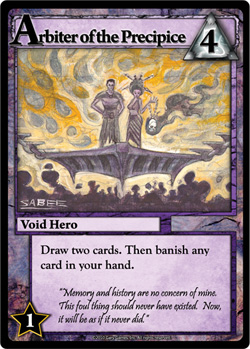A funny thing happened this past weekend. I got roped into playing in a PTQ.
Let me delineate first why I
wouldn’t
play in a PTQ, as I’m sure that’s confusing to many of you fine grinders.
First of all, Sealed Deck. I hate that format in general, but I’ve heard nothing but bad things about the Scars of Mirrodin Sealed format in particular – too bomb-oriented, not enough common answers to bombs, awkward pools with either not enough infect to make infect or not enough metalcraft to make metalcraft, everyone plays R/W (making “mirror matches” common, and whoever has the better R/W deck tends to win), and on and on. It sounded like a bad time. I tend to avoid those whenever possible.
Second of all, I hadn’t played much Magic in the past three months, including much Scars Limited. I basically wasn’t very familiar with the cards, and there were times when I had to read cards or review them to remind myself what they did. I knew that I wouldn’t be at peak performance for any long, grindy tournament. I dislike playing in tournaments that I’m unprepared for – because I dislike losing. You understand.
Third of all, I enjoy birding a lot. That’s when you just watch and don’t play. I can spend many an enjoyable hour just watching people play games of Magic.
My plan was to go to the venue (the StarCityGames.com storefront) and hang out, wait for people to drop, and then start mashing games of the
Ascension board game
all day long. I’m obsessed with this game, by the way. If you don’t know what it is or haven’t played it, I highly recommend you try it out.
However, when getting to the tournament venue, the word on the street was that there were only forty people signed up, and signups were nearly closing.
Huh. Wait, what?!
Forty-person PTQ??
My eyes lit up with dollar signs. I mean, I thought the forty-person PTQ was a mythical beast, only glimpsed in far-off places like Hawaii.
Oh, Roanoke, VA. You’ve reached new lows.
At least you have an airport. Y’know, for coming and going… or just going. Every time I move, it feels kind of like a downgrade (from sunny Pasadena to bustling Manhattan to Roanoke… is this what’s called moving up in the world?). Well, as long as there are games to be played, I’m pretty happy, so I think we’ll be okay.
The PTQ ended up being 46-ish people. Six rounds of Scars Sealed Deck and a cut to Top 8 and then a Scars draft. Nice.
Spoiler alert!
Let me cut to the end here and tell you that I did not win this PTQ. Kenny Mayer did. (Congrats, Kenny!) I didn’t want to leave you all in suspense…
My deck was R/W (obviously) and was:
1 Bloodshot Trainee
1 Copper Myr
2 Golem Artisan
1 Kuldotha Phoenix
1 Myrsmith
1 Palladium Myr
2 Perilous Myr
1 Razor Hippogriff
1 Rust Tick
1 Silver Myr
1 Spikeshot Elder
1 Arrest
1 Contagion Clasp
1 Culling Dais
1 Dispense Justice
1 Origin Spellbomb
1 Panic Spellbomb
1 Rusted Relic
1 Strata Scythe
1 Tumble Magnet
1 Turn to Slag
I used my sideboard very frequently and constantly pushed in and out cards depending on the matchup. I built my deck wrong, too, which I didn’t figure out until after game one, so I tended to swap out most of the same cards.
For one thing, that Bloodshot Trainee has only one way to get pumped: Strata Scythe. It wasn’t terrible as a 2/3, but it was probably a mistake to include him. But who knows? Getting there with Strata Scythe, even just once, might’ve made him worth it. I got there once, but he was Turn to Slagged (sadface). I assumed Golem Artisan would help, but it only pumps artifacts (durr). (Common theme throughout the day: not knowing what cards do.)
There are fifteen artifacts in the deck, which honestly isn’t enough for Rusted Relic. A lot of the artifacts in the deck have trouble staying on the board – either the opponent is incentivized to remove them or they sacrifice. Everyone has tons of artifact removal, too, since the removal is pretty concentrated in red and white, causing many to run R/W decks.
My pool was pretty easy to build; it was just several cards off from optimal. It’s entirely possible that I overvalued artifact synergies and should’ve just avoided cards that relied on metalcraft minus the Phoenix. That way, I could cut stuff like mana Myr, which seemed to not do anything (Palladium Myr was fine, though). I could’ve cut Culling Dais, which didn’t do much for me ever. (I wanted to try it, though.)
I think I might’ve wanted this as the original build:
1 Copper Myr
1 Darksteel Sentinel
1 Ghalma’s Warden
2 Golem Artisan
1 Kemba’s Skyguard
1 Kuldotha Phoenix
1 Myrsmith
1 Palladium Myr
2 Perilous Myr
1 Razor Hippogriff
1 Rust Tick
1 Saberclaw Golem
1 Spikeshot Elder
1 Arrest
1 Contagion Clasp
1 Dispense Justice
1 Origin Spellbomb
1 Panic Spellbomb
1 Strata Scythe
1 Tumble Magnet
1 Turn to Slag
Other possibilities: Chrome Steed, Wall of Tanglecord, Glint Hawk, Soul Parry, Rusted Relic, Scoria Elemental, Culling Dais, Necrogen Censer, Grindclock, Bloodshot Trainee, two Vulshok Heartstokers, Auriok Sunchaser, third Golem Artisan. What do you think I should’ve done with these cards? There was nothing to splash; the other colors were considerably weaker.
New to the format, I overvalued curve, as I tend to do. The format’s fairly slow, so it’s guaranteed you’ll get to four mana and likely that you’ll hit five mana in a timely manner.
Given that, you want substantial bodies – anything 2/2 or less hasn’t got enough meat. Although lots of fliers at 2/2 is fine. Fliers are a very good plan of attack in the format, as they usually are in Limited.
In general, it’s a good idea to minimize the effectiveness of things like Arc Trail, Contagion Engine, Perilous Myr, etc. Both in deckbuilding and during play.
Given that everyone’s playing R/W and no one’s running infect, you should build decks with that strongly in mind. Of course, you’ll probably encounter one or two infect decks and perhaps more decks that side into infect, but the format definitely feels run over by R/W.
Plan of Attack
Every deck should be built with a plan of attack in mind and a plan for winning.
My deck felt a bit controlling, but it didn’t have answers for everything. I’d need to delicately balance when to attack and when to hold back. Having flying finishers makes it easier to do both at once, so my main plan was to defend the ground and win overhead with Golem Artisan or Razor Hippogriff. Not very reliable, though, since both are easily killed. We’d cross our fingers and hope. Kuldotha Phoenix helps make this plan more reliable if we draw it, since it can come back from the grave.
Spikeshot Elder thankfully wins games on its own. This was the second line of attack. If Strata Scythe ever got on that baby, we’d be in
business.
Strata Scythe on any creature would probably finish the job, also, so that was plan of attack #3.
Unfortunately, all these win conditions are quite delicate and can easily be dealt with by common removal spells.
My main mistake, I believe, when playing out my matches was not holding on till the last possible moment to drop my game winners.
Running out a Strata Scythe on turn 3 was never a good idea, particularly against anyone running R/W. If they were B/G or U/B, that would be a different story. However, against the Boros mages, we needed to hold important artifacts in hand unless we could get it back with a Hippogriff.
Given the number of R/W decks, I also wished I’d maindecked Darksteel Sentinel, which seemed impossible to deal with without a Revoke Existence.
Playing the Games Out
I only managed to get four rounds into the PTQ, but there were a lot of interesting games along the way.
Many games felt really close.
Two of my opponents had really stacked R/W decks with lots of removal. I beat the first one of these (Cam Williams) in round one.
Game two of round one, I had been getting through with fliers every now and then and had him down to four life, but he had complete control and was about to kill me with his vastly superior board position. He had one flying blocker in Perilous Myr equipped with a Bladed Pinions. I had an Arrest in hand I’d been holding the whole game, just in case I drew my one out… and I did! Kuldotha Phoenix came swooping from the top of deck, to the rescue. Thank goodness for haste.
Game three of that round, we were running out of time, since game one took forever. We rushed, but he made some mistakes as a result, and I took it. His deck seemed better than mine, however. Oxidda Scrapmelters are a beating.
The second R/W deck (Jason Rose) had a lot of fun interactions: Glimmerpoint Stag + Oxidda Scrapmelter and Bloodshot Trainee + equipment like Darksteel Axe and Barbed Battlegear. I didn’t have any artifact removal, which made this matchup pretty hard. My only real answer to the Bloodshot Trainee combo was Turn to Slag and Arrest. Arrest was weaker against his Revoke Existences.
I lost that match.
The other match I won was against Glenn Jones, who started with a poison deck and then sided into a U/R deck. The poison deck was pretty kold to Spikeshot Elder, and I’d side in more heavy blockers, so it made sense for him to switch.
One combat phase was pretty awkward where he figured out I had Dispense Justice in hand (pretty obvious since I left mana up instead of using it on my Golem Artisan). So he swung with everything minus a 0/2 Sylvok Replica. My blockers could block without trading, so he was giving up a few creatures with the attack. But he had a Scrapdiver Serpent and a Rusted Relic and a 4/4 Mountain swinging in (Koth of the Hammer) that I couldn’t kill through combat. I had to chump-block Relic here because it was lethal damage otherwise.
After damage, I went to four life and cast Dispense Justice with metalcraft on, getting rid of his Relic and Serpent… but oh wait, he had Furnace Celebration and just killed me.
Awk. Ward. I could’ve made a different block and survived, but there were a lot of things I didn’t quite see clearly at that moment.
I beat him in game three.
In the final round against Justin Parnell, he basically comboed out on me with Grand Architect + Soliton into Golem Artisan and Myr Battlesphere.
Yeah, all right. You got me.
However, it felt weird to see him swing out in his second-to-last turn. He had everything tapped, including Grand Architect, Myr Battlesphere plus tokens, Golem Artisan, Soliton, Riddlesmith. His entire board was tapped, and he was tapped out.
I dropped my sixth land and felt sad I didn’t even have a Sunblast Angel in my deck. He killed me the turn after.
I told him afterwards that I was surprised he didn’t bother playing around the Angel, but he seemed to think his deck wouldn’t win against Sunblast Angel anyway, thus making it pointless to play around it.
Even though the Angel wasn’t in my deck, rares like Sunblast Angel and Hoard-Smelter Dragon are a dime a dozen in the format, since they’re rare (not mythic), and everyone can play them pretty easily without stretching the mana too much. And I was R/W, which would normally tip off opponents to at least the
possibility
that I had such a rare in my deck. I’ve seen plenty with both Angel and Dragon and other such nonsense in Scars Sealed.
Sunblast isn’t very hard to play around, either. You just have to be careful to leave some things untapped as insurance. In that game, in particular, I don’t think it would’ve cost him anything to play around the Angel.
Funnily, people seem to have a much harder time playing around cards like Dispense Justice and Soul Parry.
Anyway, that was my brief PTQ experience, and I learned a lot (y’know, like what Strata Scythe did, etc.). I feel my overall grasp of the format is fairly strong; unfortunately having not played many real games, I don’t have the technical prowess necessary to do well, as I mentioned at the beginning.
I think I find Magic much more enjoyable when viewing it from a theoretical standpoint. I love analyzing games and overall strategies and matchups, but playing them is a different matter and would require a lot more work than I have the time for, currently.
I’ve instead been doing a little bit of playtesting for the expansion of a different game, so let me introduce you two.
Bonus Section: Ascension Basic Strategy and Theory
This game is excellent for me because it’s less bookkeeping, and I feel the big picture is very important to keep in mind in-game. In a sense, it’s as though you’re drafting a deck
and
playing it at the same time, so you have to keep in mind your
draft
strategy at all times, and you get to
apply
your strategy simultaneously to test it.
I’m going to write this under the assumption you all have never played
Ascension,
which I’m sure most of you haven’t. You can purchase it online through the
SCG store.
But you’ve all played Magic, so I’ll use Magic terms.
Brief interlude to explain Ascension: Ascension is a two- to four-player card game where you start with a ten-card deck. Draw five cards; on your turn, you get to play those cards, which typically do one of two things – let you buy more cards for your deck or kill monsters on the board. The center row constantly fills up with six random cards that are either monsters for killing or cards for buying. As the game progresses, you tune / build your deck and constantly reshuffle cards as your library runs out, and then you redraw from your new deck. Rinse and repeat. May the best deck win!
The archetypes are not quite divided like in Magic: control, aggro, combo.
There’s definitely an aggro but no explicit control or combo (but there are elements of both). This is the most straightforward. It involves collecting cards that increase your ability to kill monsters and then… killing monsters. Killing monsters gives you honor (victory points or whatever you want to call them – whoever has the most wins at the end).
Killing monsters doesn’t require any resources other than the cards that kill monsters, i.e. cards that increase your power.
It’s almost totally brute force. You fill your deck up with power cards; you kill monsters; you earn points. Win!
The other nice thing about being the aggro deck is that you are responsible for when the game ends, generally. The more honor (victory points) you deplete from the pool by killing the monsters, the sooner the game will end, since the game ends when the honor runs out.
This parallels Magic (
Philosophy of Fire
) – the aggro deck in Magic
wants the game to end as fast as possible.
It wants to be in control of the
time
that the opponent has to play the game. Anything to shorten that time is better for the aggro deck. It’s the same in
Ascension.
On the other side of the spectrum, the “Rune” deck wants the game to last as long as possible. Runes are the equivalent of money or mana. You can spend these to buy cards to put them in your deck. There’s no straight parallel between this archetype and any Magic archetype.
This deck is all about its expensive sorceries, though. And its expensive artifacts. It likes big, splashy effects, draw spells, and value cards.
The aggro deck also likes its splashy effects, draw spells, and value cards, however. So it would be wrong to assume that aggro is incapable of getting excellent value / card advantage. Everyone can play the “feel good” cards.
Unlike in Magic, card draw isn’t all blue’s territory, and things aren’t limited by a “color pie.”
The aggro deck simply has a harder time buying really expensive cards, while the money deck has a hard time killing big monsters.
There’s an essential balance that the developers of the game worked hard on to find.
Even better, the strategies aren’t entirely linear – you can mix up power and rune cards and still have a functional deck. Some linear strategies are just very good when they’re good, and they’re pretty straightforward to put together.
One of my favorite “strategies” is to start buying money cards and “ramping” into a hand capable of buying some powerful cards and then going all-in on aggro after that. By going with money within the first turn or two, you leave your options open – money is a more widely used resource in general, and it’s hard to go wrong with it.
However, I’ve experienced lots of success by going all-in aggro from the very beginning as well.
The dynamics change a lot from two to three to four players.
They’re going to be holding Ascension Game Days and tournaments and stuff at some game stores, so I’m looking forward to those. The game isn’t geared to be super-competitive like Magic; it’s more casual. But I think playing in a tournament setting would be pretty interesting. A certain level of skill is certainly necessary, and you have to be a good opportunist and play to the cards on the board. (By the way, going first is really good.)
I’m going to show you some of the cards in the game, and kind of like a “Pack 1 Pick 1” exercise, think about which you would want to “first-pick” if you were building a deck in a vacuum.
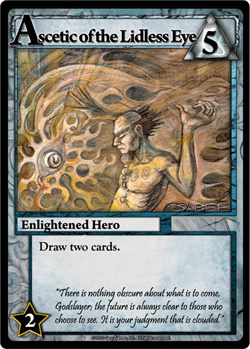
This card costs five runes (top-left corner, just like in Magic), and it draws you two cards! Divination? The starred number in the bottom left indicates the number of honor (victory points) you get at the end of the game for having it in your deck, but you can largely ignore that for the purposes of this poll.
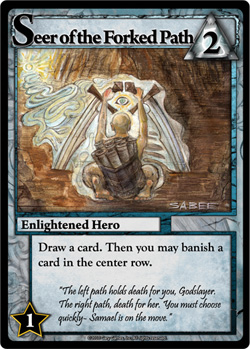
A cheap card? Not as good perhaps? But its effect is interesting – this is a “disruption” card and a “dig” card in one. You can either banish something from the center to prevent your opponent(s) from having access to it, or you can banish a card in order to “dig” for better options for yourself.
Personally, I’m a huge fan of this in two-player games where the board is much easier to control.
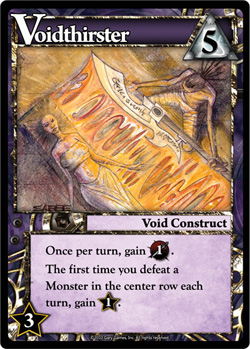
I haven’t explained constructs. They’re like artifacts; they just sit on the board when you play them. If you draw this, you can play it immediately and start gaining one power every turn. Getting this early can be pretty strong!
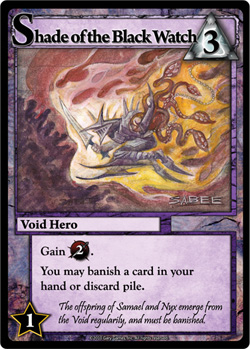
Fan favorite. Play this, get two power,
and
exile a card from your deck, never to draw it again. Banishing cards from your deck lets you fine-tune your deck – if you could run 59 cards in Constructed, you would, right? Same principle. But you start with a ten-card deck, so… this is a mite more effective.
All right, so which of those is the best? Feel free to speculate/discuss in the forums.
As a tip, I’ll show you the generally agreed upon best card to first-pick. Ask Brian Kibler. I think he’ll agree.
